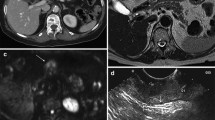Abstract
Background: To evaluate the usefulness of dynamic and delayed magnetic resonance (MR) imaging in the T-staging of stomach cancer and to compare the enhancement pattern of the cancerous lesion and the normal wall.
Methods: We performed MR imaging in 46 patients with stomach cancer (including four early gastric cancers and 42 advanced gastric cancers). Axial, sagittal, or coronal two-dimensional fast low-angle shot) MR images for the water-distended stomach were obtained with dynamic protocol, including precontrast images and images obtained 30, 60, 90, and 240–300 s after intravenous injection of the 0.1 mM Gd-DTPA/kg solution. We evaluated the thickness, interruption (or not) of the low signal intensity bands, and enhancement pattern of the cancerous wall and normal gastric wall. We prospectively evaluated the depth of cancer invasion, perigastric infiltration (extraserosal invasion), perigastric organ invasion, and regional lymph nodes and determined tumor staging on MR images. These MR evaluations including MR-determined staging were correlated with the surgicopathologic findings.
Results: Stomach cancer was shown as having a thickened wall with a rapid enhancing pattern after intravenous Gd-DTPA administration. The mucosa (and/or submucosa) affected by stomach cancer showed an early enhancement pattern (30–90 s after Gd-DTPA administration) in 43 of 46 patients (93%). The normal gastric mucosa demonstrated a delayed peak enhancement pattern (>90 s after Gd-DTPA administration) in 29 of 46 patients (63%) and variable enhancement pattern in 17 of 46 patients (37%). An interrupted low signal intensity band or highly enhanced tumorous lesion penetrating through the gastric wall was seen in 17 of 19 pT3 patients (90%). Consistency between MR-determined staging and surgicopathologic staging occurred in three of four pT1 tumors (75%), 10 of 13 pT2 tumors (77%), 17 of 19 pT3 tumors (90%), and eight of 10 pT4 tumors (80%); overall accuracy was 83%. Overall accuracy of regional lymph node involvement, as determined by enhanced MR, was 52%; 24 of 46 node groups were positive.
Conclusions: Dynamic and delayed MR imaging can be useful for predicting depth of cancer invasion, perigastric infiltration (extraserosal invasion), and perigastric organ invasion by gastric cancer.
Similar content being viewed by others
Author information
Authors and Affiliations
Additional information
Received: 28 July 1998/Revision accepted: 27 January 1999
Rights and permissions
About this article
Cite this article
Kang, B., Kim, J., Kim, K. et al. Value of the dynamic and delayed MR sequence with Gd-DTPA in the T-staging of stomach cancer: correlation with the histopathology. Abdom Imaging 25, 14–24 (2000). https://doi.org/10.1007/s002619910003
Issue Date:
DOI: https://doi.org/10.1007/s002619910003




